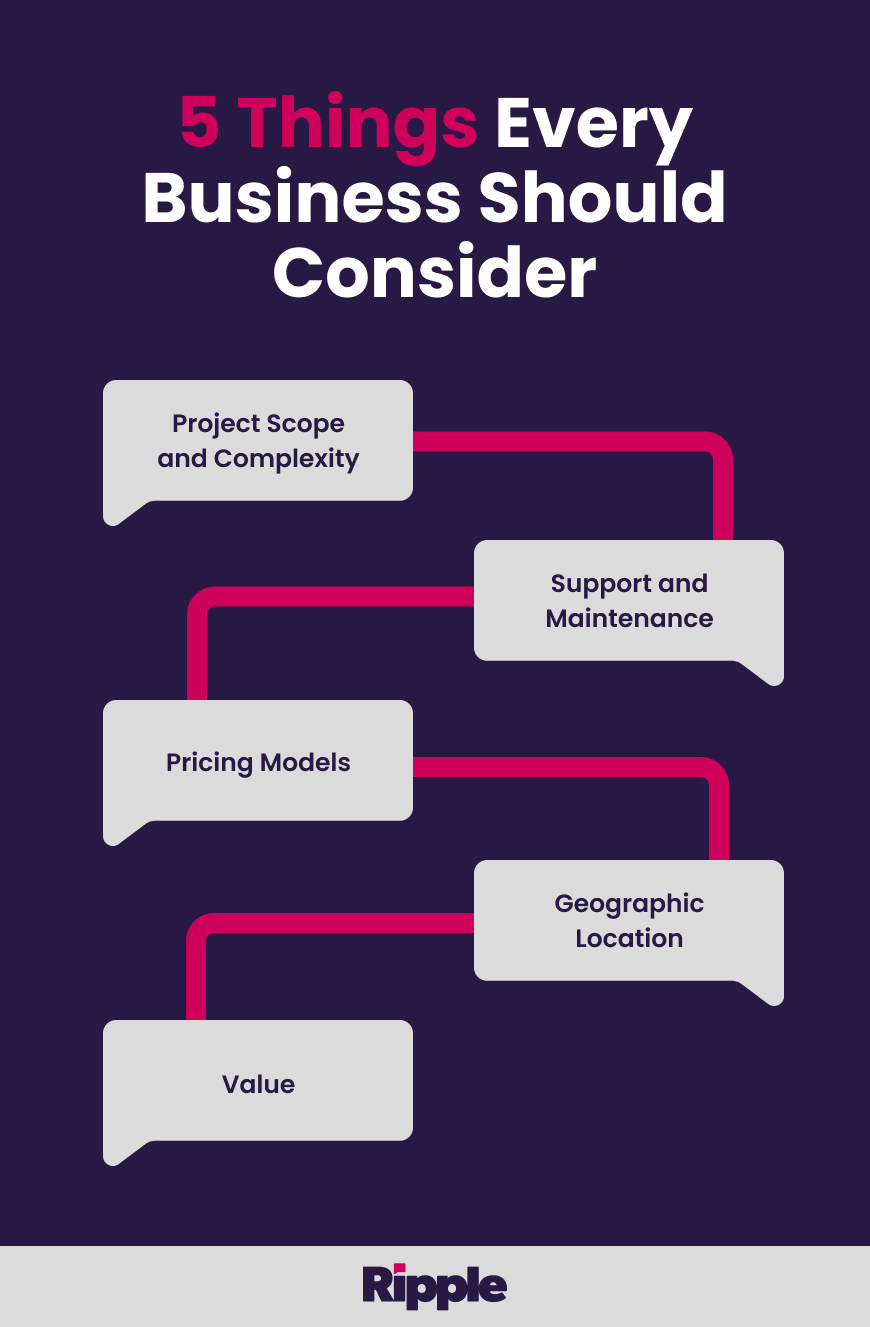
Trying to nail down how much you should budget for IT services costs can be frustrating, to say the least. For starters, every business has unique needs, goals, and capabilities. On top of that, managed service providers (MSPs) offer a wide range of services and have different approaches to doing business.
At the same time, the demands of IT, from security to ever-expanding technology needs, are getting more complicated by the day. If you work with an IT services provider that prioritizes low prices over quality, it can lead to costly issues down the road. On the flip side, you can also fall into some pricey pitfalls where contracts are bloated with unnecessary services that don’t do anything to actually improve your business.
So, what are the most important factors that impact how much IT services cost? Let's take a look at the top five things to consider.

1. Project Scope and Complexity
Ever wondered why managed IT services come with such a wide price range? It’s because there’s no one-size-fits-all when it comes to MSPs. Your scope with a managed IT services contract can be as straightforward as just help desk support or as complex as a bundled solution that includes network administration, cybersecurity, and employee onboarding. If you need a provider with specialized skills, like cybersecurity or project management expertise, that can also increase what you’re spending on IT services.
When evaluating providers, here are a few things to keep in mind:
- Does the agreement include services like change management and employee onboarding?
- How often will the provider meet with you to talk about your business and IT strategy? These meetings should be focused on the goals of the business, not selling more services or tools.
- Is there a well-defined process for dealing with service-related issues? Is the process focused on producing tangible results for your company?
2. Support and Maintenance
Support is the cornerstone of any MSP agreement and has a big impact on the cost of managed IT services. The speed of response, the expertise of the person on the other end of the line, and the effectiveness of their solution all play a part in whether they help you keep IT service costs under control, or allow issues to spiral into expensive problems.
Some things to consider when evaluating support include:
- Is help desk support limited to a certain number of hours or calls per month?
- Are help desk employees outsourced?
- Does the provider have a team dedicated to support, or are their duties spread across other responsibilities, such as project management?
- Are calls routed to a nameless, faceless call center where you just get the first rep who answers the phone, regardless of whether or not they’re familiar with your company?
Every MSP will claim to offer great support, which is obviously important. But beyond simply being great, support should be consistent. An MSP that’s structured to provide you with consistent support is more likely to address small issues before they snowball into major crises, which helps to control the cost of IT services in the long run.

3. Pricing Models
Pricing models for managed services can vary widely from provider to provider. That’s good news for buyers since you can find a pricing model that suits your budget and your needs. A few of the most common pricing structures you’ll find are per user, per device, and per hour. User-based and device-based pricing are fixed-fee models, so you get a clear picture of your costs and the flexibility to make adjustments as your user/device counts change.
Hourly pricing, on the other hand, can be more opaque. To avoid surprises every month, you’ll want to focus only on projects and tasks that are absolutely essential. That’s at odds with the provider, who needs to bill as many hours as possible. It’s not that every hourly-based provider is shady, it’s just that the hourly model creates tension between your bottom line and theirs.
Even though fixed-fee pricing models are best, all contracts aren’t the same. Here’s what to ask to tell them apart:
- What happens if you need a response after hours?
- Are backups included or do you have to pay extra?
- Are you locked into a long-term contract, or can you leave with notice?
While long-term contracts can offer you predictable, stable pricing, they may end up benefitting the MSP more than your business. If a provider knows you’re locked into a 24-month contract, they may try to get away with minimizing your service as much as possible to maximize profit in that time, regardless of whether the service meets your needs.
That’s why we’re fans of a different approach: a flat-fee, unlimited service model on a month-to-month contract, or a longer-term coupled with a 60-day cancellation period. This way, you can say goodbye to stress about unpredictable costs or feeling trapped in a contract that’s not doing you any favors.

4. Geographic Location
Ever heard the saying, “location matters?” Well, it’s not just for real estate. In the IT services world, local labor costs, market competitiveness, and even economic conditions can all play a part in the cost of IT services. To balance out high labor costs, many MSPs outsource to less expensive labor markets. But let’s be real, outsourcing to cut costs rather than improve quality can cause you to see a drop in service quality and consistency.
Location also plays a role in the cost of on-site services. If you’re considering having someone on-site full-time, the costs can add up quickly, especially in a high-cost-of-living area.
So, when you’re mulling over how location impacts IT services costs, here are a few things to consider:
- Where are the MSP’s teams located?
- Are there additional charges for on-site support?
- If you’re looking for someone to be on-site full-time, what are you expected to cover? Salary? Benefits? Equipment costs?
For small to medium-sized companies, the sweet spot is often working with a remote team that has a local presence. They can support your business remotely on a day-to-day basis, but when you need on-site service, they’re ready to swoop in. This means you’re not dependent on a single person for support, and you’re not stuck with a disconnected, inconsistent team that doesn’t understand your company. We’re telling you can have your cake and eat it too.

5. Value
When it comes to figuring out what to spend on managed IT services, it’s not just about crunching the numbers. It should be a chance to figure out what value you want to get from IT. Did you know that mid-sized businesses with a strategic approach to digital transformation are twice as likely to reach their customer experience goals than their peers? So, IT isn’t just a cost—it’s an investment in making your team more productive.
When you’re weighing whether managed IT services are giving you the value you need, ask these questions:
- Does the MSP’s philosophy align with your culture and goals?
- Does the provider focus more on features and functionalities, or do they deliver outcomes?
- Can the provider support the fast-evolving office landscape, where employees are working at home, around the world, and in the office?
Finding The Right IT Services Provider for the Right Price
Choosing an MSP can be daunting. Your decision has a direct impact on your employees, customers, and the bottom line. But when you home in on a provider that has carefully considered the value of every aspect of their approach, from their pricing model to their team structure, your business reaps the rewards.
At Ripple, we put people first. Our goal is to deliver modern IT services that meet your needs and ease your burden. If you’re ready to breathe a sigh of relief and elevate your IT operations, reach out to us for a consultation.
Ripple's IT Team
Don't Fall Behind!
Get the latest work-from-home and Humans First® IT tips straight to your inbox.